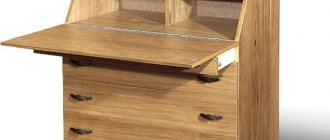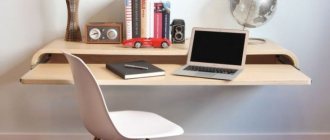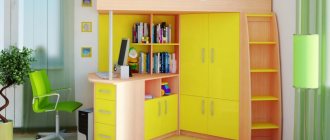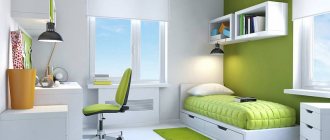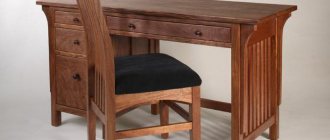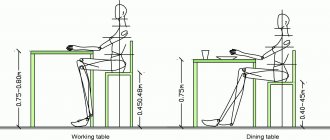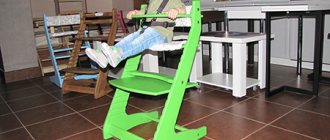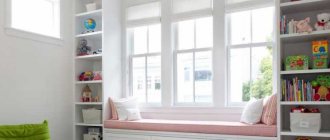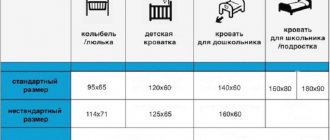Students of different ages have to complete different tasks at home. It will be convenient to prepare homework and do creative work if parents can properly organize a separate corner for it. The child’s academic performance, as well as his physical and emotional state, will depend on the correct arrangement of the workplace. Therefore, the home workplace must comply with existing standards and requirements. The schoolchildren’s corner will become the child’s full-fledged possession, where he can not only prepare homework, but also relax, engage in creativity and hobbies. Depending on the baby’s preferences, it is necessary to properly organize the work space. He should be comfortable here.
Approach to the issue
The main thing that you will have to work hard on when arranging the training area is its ergonomics. Everything here should be adapted for comfortable learning and stimulate the process. But while immersed in the selection of details, do not forget to ask how your child sees his workplace. This is very important from a psychological aspect.
Children's workplace should be ergonomic
The child’s own opinion about how certain objects, rooms, and things should look begins to form in kindergarten. Naturally, the decision on the appearance of the student’s corner is yours, but if you want your child to do his homework with pleasure, try to recreate a design that is interesting to him in this area. This can only be done by taking into account the wishes of the young student. Look for a compromise in the thematic solution of the workplace. Knowing the child’s preferences and hobbies will help with this.
When designing a children's workplace, take into account the child's tastes
The second important point will be basic convenience. A chair and table with room for growth is not a solution. Uncomfortable furniture in a compartment with poor lighting will lead to health problems. You can only avoid problems with the spine and vision if you know the rules for organizing the training area.
Simple math
Having figured out the location of the table, you also need to decide on its height. The student feels comfortable when the edge of the table is one or two centimeters below the level of his chest in a sitting position. An “adult” table with a standard height of 75 centimeters is suitable only for schoolchildren whose height has already exceeded 150 centimeters. For shorter children, a solution “for growth” is suitable - special tables or transforming desks, the height of which can be adjusted. Another option is a custom-made table, here you can experiment with shape, color and material. But a more practical choice would still be a transformer, which “grows” with the student and makes it possible to adjust the angle of the tabletop for the most comfortable learning process.
What are the requirements for a chair? There should be a backrest so as not to harm the posture, ideally anatomical, the child’s feet should touch the floor, and the knees should bend at an angle of 90°. The best choice is a height-adjustable chair. It can pair even with an ordinary “adult” table, if it turns out to be “big” for a child, but you will have to choose a footrest.
If the child is restless, a swivel chair on wheels is contraindicated - it will inevitably be used as a means of transport.
Children's workplace: arrangement rules
Step 1. Zoning
The first thing you will encounter when organizing a work area is the choice of location and its zoning. With the right decision, the student will be isolated from all the temptations present in the nursery and will be able to concentrate directly on the work process.
Zoning of a children's workplace
This does not mean that the child should be driven into a remote corner, surrounding the area with a stationary partition. Confinement of space can negatively affect performance. It is better to use for these purposes:
1. Mobile screen.
2. Curtain.
3. Open shelving.
Zoning workplaces using open shelving
As for the choice of location for organizing the study area, then, for obvious reasons, the best option would be a section of the room near the window.
Step 2. Set up the table
If possible, the table should be placed with the left end facing the window. For left-handers, this rule is exactly the opposite. They need the light to fall from the right, therefore, the table will have to be turned 180°. It is advisable that the wall be behind the child’s back, and not loom before his eyes.
An adequate solution would be to install a table in front of the window.
The optimal position for a child's desk is in front of the window.
In principle, there is always an opportunity to successfully arrange one table in a nursery, but what to do if there are two students? For this case, there are also several schemes for arranging a children's workplace. Tables can be placed:
1. Single row.
2. In parallel.
3. L-shaped.
Everything will depend on the layout of the room itself and the number of windows in it.
With a single-row arrangement between children's tables, you can make a passage or separate them with a piece of furniture, a screen, etc. This step will help students not distract each other from doing their work.
Single-row arrangement of children's tables
With tables arranged in parallel, for the same purpose, it is enough to simply seat the children with their backs to each other.
Parallel arrangement of children's desks
In an L-shaped layout, it is not necessary to use two separate tables. You can buy one corner.
Corner workplace for two children
Step 3. Selecting a table
Design
“The presence of a toy in a child’s workplace will create a specific mood that in no way corresponds to the assigned tasks.”
The main point in choosing a table is its suitability for the child’s age. If you plan to install a computer in your work area, place it on a separate table. Why? The problem is children's perception of this accessory. They look at the computer as a means of entertainment and define it, especially at an early age, as a toy. The presence of a toy in a child’s workplace will create a specific mood that does not in any way correspond to the assigned tasks. In addition, a desktop computer requires a table of a non-standard design with a retractable panel for the keyboard and other nuances. In a small area, it is permissible to use a corner table, which allows you to allocate an area for writing and installing a laptop.
A corner desktop will solve the problem with installing a computer
When choosing a desk model, look for options with tabletop adjustments. It will be much more convenient for the child to write if it can be installed at an angle. At such a table it will be much more comfortable to draw and draw.
Children's table with adjustable top
Dimensions
The table should have proportions that suit your child. This model can be considered an option where the table top is located just below chest level and when sitting at which the child has the opportunity to comfortably rest his elbows on it without raising his shoulders or slouching. For kids with a height of up to 120 cm, you should look for tables with a height of up to 52 cm. For teenagers, designs with a height of up to 61 cm are suitable. The “adult” standard is tables with a height of 75 cm.
Table size according to child's height
The ideal table model is considered to be a transformable design with the ability to adjust the height of the tabletop and adjust its position. This is a purchase for the ages. With such a children's workplace, your child will not only graduate from school, but will also work as a student.
Children's transforming table
Material
Don’t chase the exotic and don’t become hostage to the interior style. You should not take your child to glass or plastic tables. Besides the fact that they seem fragile, they are really cold and have a slippery surface. It is better to remain conservative in this matter and buy a standard wooden model of good quality. When inspecting the product you are interested in, make sure that there are no cracks, untreated areas, traces of glue or other defects. The reason to leave a table in a store is the unpleasant smell emanating from it. As a temporary option, an economy class table made of laminated chipboard can be purchased.
Reliable children's desk made of wood
You should not experiment with the design either. Take a standard rectangular table that stands firmly on legs, has a back panel and a built-in cabinet.
In a small nursery, where installing a regular table is problematic, you can solve the issue of arranging a children's work area in other ways. For example, converting a window sill into a study table.
Organization of a children's workplace on the windowsill
This is done by replacing the standard window sill with a deeper countertop. Under it you can place a free-standing mobile cabinet. A series of holes must be made in the surface of the makeshift table, closer to the window. This is necessary to organize proper ventilation of the area. In the cold season, the heat coming from the radiators will prevent the window from fogging up and molding. For such a specific workplace, you will have to purchase a transforming chair with adjustable seat height and possibly a footrest. The latter can be a low bench or even books.
An interesting option would be a folding table attached to the wall. A hinged lid of a sideboard or bureau can replace a full-fledged table.
Folding children's workplace
Step 4. Choosing a chair
The child will spend a lot of time at the desk, so he should be able to sit comfortably. Stools, poufs, and soft chairs are not suitable for this. The chair you need should have a firm back that has a slight curve to allow your child's back to fit snugly against it. The design of the model should not have armrests. From a medical point of view, the optimal solution would be an orthopedic chair or a regular chair without wheels.
Children's chair with orthopedic back
When sitting on a properly selected chair, your child will keep his knees bent at a precise right angle. In this case, your feet will be completely on the floor, and not resting on your toes. If the last condition is not met, use a stand. A distance of 20–30 cm should be maintained between the table top and the seat of the chair.
Rules for organizing a children's workplace
Teach your child the rules of sitting at a children's workplace. Explain to him that he must keep his back straight, not lean to the sides, lean back, or lean on the tabletop. There should be at least 8 cm of free space between its edge and the student’s chest.
Step 5: Lighting
“Avoid contrast lighting in the children’s workplace”
After the furniture issue has been resolved, it’s time to move on to organizing the lighting. Artificial light must have an adjustable supply. A table lamp should allow directing light flows and have a shade or lampshade. Do not illuminate the child’s workplace with fluorescent lamps and halogen lamps. Stick with sixty-watt incandescent or LED bulbs.
Comfortable table lamp for a child
The rules for supplying artificial light remain the same as for daylight. For left-handers, the lighting device is placed on the right, for right-handers - on the left.
Avoid contrast lighting in the children's workplace. In addition to the table lamp, the room should include sconces or a chandelier with dimmed brightness. This will make the light diffusely soft and prevent children's eyes from getting tired.
If the child's desk is located away from the window, for example, located under a loft bed, then you will have to use a table lamp even during the daytime.
Step 6. Organize your storage system
Work productivity is ensured by many factors, one of which is the order in the child’s workplace. To establish and maintain it, storage systems are designed to be organized in such a way that all items are laid out, as they say, “on shelves” and at the same time are always within reach.
Storage system for children's workplace
The presence of a cabinet and drawers in the table will allow you to place many necessary little things in them. When sorting them, be guided by the principle: the more often a child needs a given item, the closer to him it should be stored. Therefore, in the top drawer of your desktop you should send:
1. Workbooks.
2. Textbooks.
3. Paints and pencils.
4. Sharpener.
5. Rulers.
6. Erasers.
It is possible and even necessary to organize desktop storage systems. Office organizers will cope with this task perfectly. You can put pens, buttons, paper clips in them. Small items can also be stored in transparent plastic containers. A school mini-library can be located on open shelves or in niches.
Desktop storage system for the workplace
For ease of use of the children's workplace, containers and drawers should be signed. This is a great way to not only save time on finding the right accessories, but also teach your child to maintain order.
The following can be permanently located on the desk:
1. Book stand.
2. Lamp.
3. Stationery organizer.
4. Clock.
If desired, a trash can can be placed under the table.
Step 7. Working on the decor
Studying and creativity should be of interest. The child will be happy to spend time at the workplace if he likes it. This means that you will have to start decorating it in order to somewhat personalize the space. You shouldn't get too carried away with the delights. You can add coziness with neutral colors and a small amount of decorative elements. The latter should be thematic and carry a semantic load.
Personalization of children's workplace
A miniature school board, enclosed in a nice frame, will do. You can write a schedule on it, mark important tasks, and place training reminders. The accessory can be wooden or cork. Then all of the above will be written on paper and attached to it with buttons.
Chalk board for children's workplace
You can post the necessary information directly on the tabletop, under plexiglass. A globe will become a trendy decoration for a child’s workplace. In addition to its aesthetic appearance, it will help in studying geography.
You can decorate the area with posters and placards with stimulating inscriptions, mottos, and phrases. A good solution would be interior letters, as well as numbers, which are not difficult to make yourself. They can be mounted on the wall or placed on shelves and niches, and it is not at all necessary to do this in an orderly manner.
Decorating a children's workplace
Step 8: Creative Accessories
Instead of boring scissors and small office supplies, buy your child accessories of unusual shapes and bright colors. It will be much more interesting for a child to put pens in an organizer shaped like a cheerful hedgehog than in a boring glass and fix abstract sheets with multi-colored paper clips. Interesting accessories are not just a waste of money. This is one of the ways to instill interest in the educational process.
Pay attention to the bright children's stationery
Additional furniture
It is very important for a student to properly organize the space around him. If there are a lot of unnecessary things nearby, piled up in large piles, this will not promote concentration. The student's attention will wander. The student's workplace at home should have additional furniture. These can be various bedside tables, wall cabinets, shelves or bookcases. It all depends on the style of the interior, as well as the free space in the room. Textbooks, notebooks, and office supplies should be at hand. The student should have easy access to them. Therefore, it is necessary to install all additional furniture elements so that the child can simply reach the cabinet or shelf. Cabinets should not be hung high. Due to inconvenient access to their things, the child will feel discomfort. His workplace will evoke negative associations.
Storage systems
Many factors influence productivity, and a tidy desk is one of them. It is important to properly organize storage systems: put pencils in special glasses, place books on additional shelves, put notebooks in niches and drawers. It is also good to use magnetic, cork, and slate boards, on which it is convenient to leave important notes and attach notes. Children often forget something, so such an item will teach him to self-organize.
The emotional side of arranging a children's workplace
Being at a desk should be conducive to calm and focused work. This can be ensured by the color scheme of the area. The role of colors in a person’s emotional state cannot be ignored. So which shades should you pay special attention to?
Green spectrum
Shades of green will help create an atmosphere of moderate calm in the work area, not relaxing, but stimulating to measured, deliberate actions and calling for reflection. If you remember your school years, you will understand why this color always prevailed in the classrooms. It is not necessary to make green the background color. It will be enough to enter it in the elements.
Children's workplace in green tones
Yellow spectrum
This is a catalyst for the child’s intellectual activity. However, you should not use it in large quantities or in its pure form. He will also play his role, appearing in minor accents. Such a “color spot” can be a decorative sun, a bright chair, or cups for pencils.
Yellow colors for a children's workplace
Brown spectrum
Its colors can stimulate the brain and help focus attention. They should also be added to the decor as measured accents.
Brown color will help your child concentrate
It is better to use neutral colors as the background color of the work area. Beige and white will work great. They will be able to emphasize the brightness of the furniture and surrounding accessories. There should not be an excess of elements in the color scheme. The tonal cacophony, as well as the rainbow painting of the workplace, will not allow the child to get down to business. He will be constantly distracted from his main work.

